Based on the Montessori approach, Practical Life activities are everyday life experiences that a child may observe adults complete in their daily routine. These activities give the child a sense of belonging as they gain knowledge to accomplish life skills in a purposeful way.
"Adults work to finish a task, but the child works in order to grow and is working to create the adult, the person that is to be" (Maria Montessori)
The following article provides examples of Practical Life activities which can be added into the curriculum plan. The activities can be added to any curriculum plan regardless of what teaching method you are using.
When including Practical Life activites within the room environemnt, it gives the children an opportunity to use child size tools to do the same as they see adults perform such as pouring, sweeping, ironing, polishing, scrubbing etc.
When a child is involved in these types of activites, they develop a range of skills which improves concentration, co-ordination, control, independence and order which develop a foundation of learning.
All prctical life activities help children gain gross motor control and exercise finger muscles to develop fine motor skills and hand eye corordination which will enable them to successfully perform more precise tasks in the future.
Generally, thy revolve around four areas such as:
Caring for the Self
- Changing Shoes,
- Putting on slippers
- Dressing frames:-Zip, Velcro, Buttons, Press Studs, Hook & Eye, Buckling, Bow Tying, Lacing
- Polishing Shoes
- Folding Clothes
- Care of Teeth, Nails, Hair
- Hand washing
- Washing hands/face
- Washing hair
- Blowing nose and properly throwing away the tissue
- Sneezing
- Brushing teeth
- Combing hair
- Trimming fingernails
- Running water in the bath
- Hanging up towels after use
- Dressing oneself (including learning how to button, zip, snap, tie, buckle, Velcro)
- Hanging a jacket on a low hook
- Putting clean clothes in a drawer
Caring for the Environment
- Dusting,
- Sweeping,
- Polishing,
- Tidying
- Use of Clothes Pegs,
- Washing up
- Scrubbing of Tables, Floor,
- Care of Garden,
- Picking fruit/vegetables from the garden
- Care of Indoor plants,
- Planting Seeds
- Care of Pets
- Wringing a wet cloth
- Washing a table or countertop
- Sweeping the floor with a broom and dustpan
- Mopping, using a vacuum on the floor
- Polishing silver, brassand/or wood furniture
- Sorting laundry by colour and matching socks
- Folding napkins
- Ironing handkerchiefs or pillowcases
- Sewing on buttons
- Washing dishes
- Watering and caring for houseplants
- Flower arranging
- Caring for pets
- Cleaning up spills
- Putting materials and toys away
- Sorting recycling materials
- Grace and Courtesy
- Greeting People,
- Interrupting with ‘Excuse Me’
- Coping with an offence
- Conduct with a visitor
- Speaking to a Group
- Behaviour on Outings,
- Apologising
- Waiting turns
- Table Manners and Use of Eating Utensils
- Serving and Sharing Foods
- How to greet someone
- How to answer the telephone
- How to get up from the table
- How to carry a chair properly
- How to open and shut a door quietly
- How to interrupt when necessary
- How to excuse oneself when passing or bumping into another
- How to hand someone something
- Table manners
- Carrying objects without dropping or spilling
- Walking without bumping objects or people
Movmement Of Objects
- Development of Fine Motor Skills –pouring, transferring
- Opening & Closing
- Threading,
- Cutting, Sewing, Folding
- Walking on the line
- Playing the Silence Game
- Pouring and transferring liquids and dry ingredients without spilling
- Using scissors
- Opening and closing lids
- Screwing and unscrewing jar lids
- Stirring
- Measuring liquid and dry ingredients
- Peeling fruits and vegetables
- Using kitchen tools (fork, spoon, grater, blunt knife, ice cream scoop, bulb baster, peeler, chopping board, rolling pin, whisk, pitcher, cookie cutters, melon baller, apple corer, etc.)
- Spreading (like butter, peanut butter, a mixture
*These experiences listed above are just some of the examples that can be incorporates into the curriculum. You should also remember to the Practical Life activites are culutral and specific to the child's time and place.
Practical Life activities have the purpose of allowing children to gain independence and self-discipline. They are routines and rituals that adults perform daily in order to maintain their environment.
References:
Montessori Practical Life Curriculum
An Introduction to Practical Life, Montessori Guide



 Here is the list of the EYLF Learning Outcomes that you can use as a guide or reference for your documentation and planning. The EYLF
Here is the list of the EYLF Learning Outcomes that you can use as a guide or reference for your documentation and planning. The EYLF The EYLF is a guide which consists of Principles, Practices and 5 main Learning Outcomes along with each of their sub outcomes, based on identity,
The EYLF is a guide which consists of Principles, Practices and 5 main Learning Outcomes along with each of their sub outcomes, based on identity, This is a guide on How to Write a Learning Story. It provides information on What Is A Learning Story, Writing A Learning Story, Sample
This is a guide on How to Write a Learning Story. It provides information on What Is A Learning Story, Writing A Learning Story, Sample One of the most important types of documentation methods that educators needs to be familiar with are “observations”. Observations are crucial for all early childhood
One of the most important types of documentation methods that educators needs to be familiar with are “observations”. Observations are crucial for all early childhood To support children achieve learning outcomes from the EYLF Framework, the following list gives educators examples of how to promote children's learning in each individual
To support children achieve learning outcomes from the EYLF Framework, the following list gives educators examples of how to promote children's learning in each individual Reflective practice is learning from everyday situations and issues and concerns that arise which form part of our daily routine while working in an early
Reflective practice is learning from everyday situations and issues and concerns that arise which form part of our daily routine while working in an early Within Australia, Programming and Planning is reflected and supported by the Early Years Learning Framework. Educators within early childhood settings, use the EYLF to guide
Within Australia, Programming and Planning is reflected and supported by the Early Years Learning Framework. Educators within early childhood settings, use the EYLF to guide When observing children, it's important that we use a range of different observation methods from running records, learning stories to photographs and work samples. Using
When observing children, it's important that we use a range of different observation methods from running records, learning stories to photographs and work samples. Using This is a guide for educators on what to observe under each sub learning outcome from the EYLF Framework, when a child is engaged in
This is a guide for educators on what to observe under each sub learning outcome from the EYLF Framework, when a child is engaged in The Early Years Learning Framework describes the curriculum as “all the interactions, experiences, activities, routines and events, planned and unplanned, that occur in an environment
The Early Years Learning Framework describes the curriculum as “all the interactions, experiences, activities, routines and events, planned and unplanned, that occur in an environment


